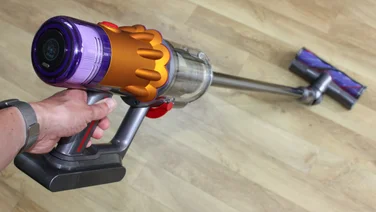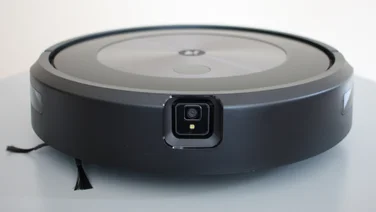To help us provide you with free impartial advice, we may earn a commission if you buy through links on our site. Learn more








- Superb mapping
- Avoids messy obstacles
- Generally good at cleaning, scheduling and voice control
- Slower than some rivals
- Bumps into tables and chairs
Obstacles such as cables, toys and remote controls have traditionally been the bane of robot vacuum cleaners. They get in the way, tangle the vacuum’s brush and generally slow things down; the iRobot Roomba j7, however, has been trained to avoid them.
With this robot vacuum cleaner, you don’t have to go from room to room tidying nests of cables, even the first time the robot scouts out your floor plan. Instead, it spots potential obstacles as it goes and works around them, leaving you free to set a schedule and put your feet up. It even works with pet mess, which will be great news for anyone who has had the unpleasant experience of a robot vacuum running over dog poo – and then going on to spread it around the house.
iRobot Roomba j7 review: What do you get for the money?
There are two versions of the iRobot Roomba j7. I tested the basic j7, which costs £700 and comes with a basic charging station that sits against the wall and charges the robot when not in use. There’s also a Roomba j7+, which costs £200 more and comes with a self-emptying base station. This is essentially a second vacuum that empties the robot’s collection bin into a larger bag, so you don’t have to do it manually. The robot itself is identical regardless of which option you go for.








The Roomba j7 is a standard puck-shaped affair measuring 338 x 335 x 92mm (WDH) and weighing 3.3kg. Its obstacle-detecting equipment is front- rather than top-mounted, leaving it free to squeeze beneath low-lying furniture more effectively than robots that have sensors mounted in a turret.
On the underside, it has two rubber rollers that rotate in opposite directions, catching dirt between them and lifting it up into a 170mm-wide suction inlet – the same system you’ll find on the cheaper iRobot Roomba i3+. I’ll get onto its cleaning results below, but it’s not too much of a spoiler to say that it performs better than most alternatives that use a single brush roller.








Its collection bin is a relatively small 400ml but I found it could handle a full clean of my 57m² ground floor without needing to be emptied part of the way around. Opt for the self-emptying j7+ and you won’t have to touch it for weeks.
The main differences between this model and the mechanically similar i3 are the sensors and the mapping ability. The Roomba j7 has a camera mounted into the front of the casing, where the i3 is essentially blind and uses only bumpers to find its way around.
Also, while the Roomba i3 doesn’t store a map from one clean to the next, the j7 builds up a constantly evolving plan of the spaces you set it to clean, ensuring speedier, more efficient cleaning. It also lets you choose which areas the robot should work in without needing to shut doors.
READ NEXT: Clean without effort using the best robot vacuums
iRobot Roomba j7 review: What’s it like to use?
Controlling the Roomba j7 is a straightforward job using the free companion app (available for iOS and Android). The first time you set it off it automatically starts building a map of its surroundings, exploring your house as it vacuums to gather information about the layout and any obstacles it finds.
If the area is large it might take a couple of trips to gather all the information it needs, although you can choose to set the device off to work on its map without performing any cleaning if you want to hurry the process along.
Once the map is built, you can view it in the app. Any obstacles the j7 has found are marked as no-go zones and some provisional boundaries are placed to break the map down into rooms. You can move, remove and add to these, and call the rooms whatever you like. Once complete, you can set the robot off to clean everything, or send it to one or more room.








The Roomba j7 can also store maps of multiple floors and will work out automatically which floor it’s on whenever you move it up and down stairs, too. I tested it in a two-storey house and it worked perfectly.
Naturally, you can set the j7 to clean on a schedule if you like, and there’s also a handy option to have it set off whenever it senses the smartphone you’re using to control it has left the house. iRobot has even put extra thought into how the vacuum’s Alexa and Google Assistant support works, allowing you to ask it to clean particular areas in addition to asking it to start and stop cleaning.
Emptying the dust collection bin is a straightforward process – simply press a button on the back and it pops out, ready to take to the bin – and cleaning is easy, too, although you need to remove the filter before washing the dust collection bin with water.








And you shouldn’t need to free the rollers of hair too often, either. Indeed, I found the Roomba’s rubber rollers stayed free of entanglements the entire time I used it – and that’s very unusual for a robot vacuum in my house.
iRobot Roomba j7 review: Is it good at finding its way around?
The Roomba j7 has a camera mounted on the front, so I was hoping it might be more careful around furniture than the Roomba i3, which only navigates by bumping into items and setting off in a different direction.
Indeed, I was hoping it might follow the approach of the AEG RX9.2, a robot that uses its front-mounted camera (in combination with laser mapping) to tiptoe around furniture, carefully reversing and manoeuvring its way around chair and table legs as if it were apologising for even approaching.
In fact, it’s just as rough as the Roomba i3 around furniture, which is odd given that the j7 proved to be more than capable of spotting other hazards and avoiding them. I tested it by throwing down socks, USB-C cables and fake poo in its path – and found it carefully gave them all a wide berth.
This is probably why it doesn’t dodge furniture in the same way, as it needs to get within touching distance of solid objects to get its sweeping brush in position to do a decent clean around.
When it’s not avoiding obstacles, the robot follows a reasonably intelligent pattern, covering the bulk of an area in a series of stripes, then going around the edges for a final finish. It didn’t seem to be quite as efficient at this as some other robots we’ve tested, covering 57m² in 1hr 10mins. The Eufy Robovac X8, for example, covered this same space in 52 minutes, with very similar performance in our cleaning tests.
iRobot Roomba j7 review: How well does it clean?
The iRobot Roomba j7 proved to be a proficient cleaner on both carpet and hard floor – with one small caveat. Annoyingly, iRobot has removed the spot-cleaning function that performed so very well in the Roomba i3.
Instead of placing the robot near a spill and pressing a button, you have to use the mobile app to send the j7 to the location you want it clean, which is more fiddly. It also tackles spot cleaning in a different way to the Roomba i3 and, as a result, it’s not quite as effective.
This has a number of other limitations. If the area to be cleaned is small, I found the j7 performed a couple of zigzags over the area and left it at that. Larger areas get the full pass, with lines and a perimeter clean, but as selecting the area to be cleaned is not particularly precise, it’s impossible to focus the robot on the worst part of the mess.
Despite this, I found the j7 performed well in our tests. With a 50g spill of dry rice on hard floor, it gathered a full 50g. This wasn’t quite everything, as a bit of scatter sent some grains into areas the robot couldn’t reach, but covering a relatively large area (because the spot clean seemed to work better that way) helped the j7 out on this occasion. It didn’t manage to pick up quite so much rice on the carpet, but it still managed to gather 43g.
Cleaning up our flour spillage proved a tougher task. It did a fair job on hard floor, collecting 42g out of 50g. A second pass helped considerably, although I did have to set this off manually. The biggest disappointment was the flour test on carpet, where the vacuum collected only 26g of a 50g spill. The Roomba i3 was much better at this test, able to capture more flour before being spread around by the edge sweeping brush and trodden into the carpet by the wheels.
Despite this, however, I was generally pleased with the way the j7 handled regular cleaning. The rug in my family room gathers lots of bits from a significant amount of footfall, and a regular pass from the Roomba kept it looking clean and bright. It proved just as good at picking up crumbs and other dirt from hard floor around the kitchen table.
READ NEXT: The best cordless window vacuums
iRobot Roomba j7 review: Should I buy it?
Although the Roomba j7 fell behind the Roomba i3 in terms of its spot cleaning ability, I found its overall cleaning remained excellent. There’s something about its rubber roller brushes that seems to work very well, agitating carpet, coping with hard floors, avoiding hair tangles and generally doing a superb job of cleaning the floor.








However, it’s the collision detection that won me over. Cables and items of clothing can cause problems for other robot vacuums and I dread to think what might happen if a less intelligent robot came a cropper with dog mess; the Roomba j7 avoids such accidents with aplomb and the upshot is that you can happily set an automated cleaning schedule without worrying that you need to clear the decks before it starts.
The only other niggle is how clumsy it is around furniture, bashing into table legs like it’s playing blind man’s buff. I can’t see it causing any damage – it often slows down before impact and the bumper is hard plastic but spring mounted.
If you have delicate antique furniture in the house, the gentler AEG RX9.2 will provide more peace of mind that your vacuum isn’t bashing it about. I also like the RX9.2 for its unique triangular shape, which is good at getting into corners and smaller spaces.
The Roomba j7 is a little on the expensive side, too. The additional control you get over an i3 is definitely worth it if you have a larger space and don’t want a vacuum bumbling around quite so much, but the i3 is cheaper and its cleaning ability is just as good, if not better, if you count its superior spot cleaning skills.
If you want a faster clean, you might want to consider the Eufy Robovac X8. This performed similarly to the Roomba j7 in our cleaning tests but doesn’t have the same classy feel or object avoidance, and it lacks the little details like the mesh that protects the filter and makes the collection bin easier to empty.







